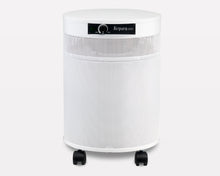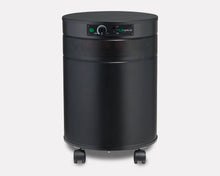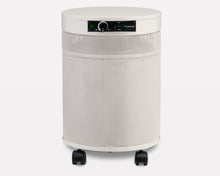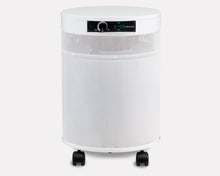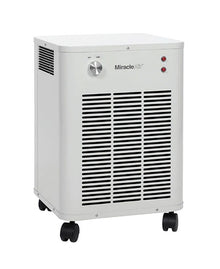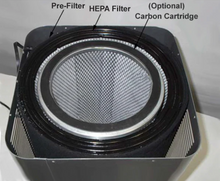Navigating the Germ Gauntlet: How Parents Can Keep Home Air Clean as Kids Head Back to School

As the vibrant days of summer wane, a familiar rhythm returns to households across the nation: the back-to-school season. For parents, this annual transition brings a mixture of excitement and a touch of trepidation, especially concerning the inevitable influx of sniffles, coughs, and sneezes that often accompany classroom camaraderie. The reality is, schools can be hotbeds for airborne illnesses, and what starts as a mild cough in the classroom can quickly become a household epidemic. At Commercial Air Purifiers, LLC, we understand these concerns deeply. We believe every parent deserves to feel confident that they’re providing the cleanest, healthiest environment possible for their children, particularly as they navigate the germ-filled corridors of schools. This comprehensive guide is designed to empower you with actionable strategies to safeguard your home’s air quality, offering peace of mind even when the school-year sicknesses begin to spread.
The Invisible Invaders: Why Back-to-School Means More Germs
The back-to-school period isn't just about new backpacks and fresh pencils; it's also a prime time for the spread of airborne pathogens. Children, by nature, are often less diligent about hygiene than adults. They share toys, sneeze without covering their mouths, and spend hours in close quarters with their peers. This creates an ideal environment for viruses and bacteria to spread. Consider the sheer volume of air shared in a typical classroom – a confined space where dozens of children are breathing, talking, and interacting for hours each day. Each cough or sneeze can release thousands of tiny droplets, or aerosols, into the air, carrying viruses like influenza, rhinovirus (the common cold), and even more serious pathogens.
According to a study published in Applied and Environmental Microbiology (2018), respiratory viruses can remain viable in airborne aerosols for several hours, depending on factors like humidity and temperature. This means that even after an infected child has left a space, the air can still harbor infectious particles. What happens at school doesn't stay at school. Children bring these microscopic invaders home on their clothes, in their hair, and most significantly, in their respiratory systems. Once inside your home, these airborne particles can circulate, potentially infecting other family members, including younger siblings, immune-compromised individuals, or even parents themselves. The challenge for parents, then, is to create a robust line of defense against these invisible invaders, transforming their homes into havens of clean air.
Proactive Air Care: Keeping Your Home’s Air Clean Before Illness Strikes
Prevention is always better than cure, especially when it comes to airborne illnesses. As Commercial Air Purifiers, LLC, we advocate for a multi-pronged approach to maintaining superior indoor air quality, starting with proactive measures before the cold and flu season hits its peak.
-
Ventilation is Key, But Often Insufficient: Opening windows and doors can certainly help dilute indoor airborne contaminants by introducing fresh outdoor air. However, this isn't always practical, especially during extreme weather, or if you live in an area with high outdoor pollution (pollen, smog, etc.). Furthermore, natural ventilation alone may not be enough to effectively remove viral aerosols, especially in homes with limited airflow or during periods of high occupant density.
-
Regular Cleaning and Disinfection of Surfaces: While this blog post focuses on airborne pathogens, it's crucial to remember that germs can also live on surfaces. Regularly cleaning and disinfecting high-touch surfaces like doorknobs, light switches, and remote controls can help reduce the overall germ load in your home. This is particularly important for surfaces that children frequently touch.
-
Emphasize Hand Hygiene: This seems obvious, but consistent and proper handwashing is a cornerstone of preventing germ spread. Teach your children to wash their hands thoroughly with soap and water for at least 20 seconds, especially after coughing, sneezing, using the restroom, and before eating. Hand sanitizer can be a good backup when soap and water aren't available, but it's not a substitute for proper washing.
-
The Role of Air Filtration in Your HVAC System: Your home's heating, ventilation, and air conditioning (HVAC) system plays a crucial role in circulating air. Upgrading your HVAC filter to a higher MERV (Minimum Efficiency Reporting Value) rating can significantly improve its ability to capture airborne particles. We generally recommend MERV 11 or 13 filters for residential use. These filters can capture smaller particles, including some bacteria and mold spores. However, it's important to check your HVAC system's specifications before installing a higher MERV filter, as some systems may not be designed to handle the increased airflow resistance. Even with a good HVAC filter, the filtration is only active when your system is running, and it may not be sufficient for targeting microscopic viral aerosols with the efficiency needed during peak illness seasons.
-
Strategic Placement of Portable Air Purifiers: This is where dedicated air purification truly shines. While HVAC systems offer whole-home filtration, portable air purifiers provide targeted, continuous air cleaning in the rooms where your family spends the most time – bedrooms, living areas, and playrooms. When selecting an air purifier, look for models that utilize a multi-stage filtration system, including a True HEPA filter, which is designed to capture 99.97% of airborne particles as small as 0.3 microns. This includes dust, pollen, pet dander, mold spores, and crucially, many airborne viral and bacterial particles. Additionally, an activated carbon filter is essential for removing odors and volatile organic compounds (VOCs). We at Commercial Air Purifiers, LLC, understand that the presence of children often means more odors and unique airborne challenges, and our range reflects this understanding.
When Airborne Illness Strikes: Mitigating the Spread
Despite all the proactive measures, the reality is that sometimes, illness will find its way into your home. This is where a robust strategy for managing airborne pathogens becomes even more critical. If one of your children develops an airborne illness, your focus shifts from prevention to containment and mitigation.
-
Isolation, When Possible: If feasible, try to isolate the sick child in a separate room. This limits their respiratory droplets from spreading throughout the entire home. Ensure the sick individual is using tissues to cover coughs and sneezes, and disposing of them immediately.
-
Increased Ventilation in Affected Areas: While the child is isolated, increase ventilation in their room. Opening a window, even a crack, can help. However, as noted before, this might not be enough to truly scrub the air of viral particles.
-
Targeted Air Purification for the Sick Room: This is arguably the most impactful step you can take. Placing a high-efficiency portable air purifier directly in the sick child's room can significantly reduce the concentration of airborne viral particles. The air purifier works by continuously drawing in air, trapping the contaminants in its filters, and then releasing clean air back into the room. This can help protect other family members from inhaling the same airborne germs. For instance, a study published in Scientific Reports (2020) demonstrated that portable air purifiers with HEPA filters can effectively remove airborne influenza virus from a room, reducing the risk of transmission. The rapid air changes provided by an effective air purifier, measured by its CADR (Clean Air Delivery Rate), are crucial in this scenario. Commercial Air Purifiers, LLC designs units with high CADR values to ensure rapid air turnover and efficient particle removal, even in larger spaces.
-
Continuous Air Purification in Common Areas: Even with isolation, airborne particles can still drift. Running air purifiers in shared living spaces and other bedrooms can provide an additional layer of protection for the rest of the family. The goal is to create a clean air zone throughout your home, minimizing the chances of cross-contamination.
-
Humidification (with caution): Maintaining optimal humidity levels (between 40-60%) can also be beneficial. Some research suggests that viruses may survive longer in very dry or very humid conditions. However, be cautious about over-humidifying, as it can lead to mold growth.
-
Consistent Hand Hygiene for Everyone: Reinforce handwashing for all family members, especially those interacting with the sick child.
-
Disinfection of Surfaces: Continue to regularly disinfect high-touch surfaces throughout the home, especially those touched by the sick individual.
The Science Behind Air Purification and Illness Prevention
To truly understand how air purification helps, it's important to grasp the science behind it. When we talk about airborne illnesses, we're primarily concerned with tiny particles, often called aerosols, that are expelled when someone coughs, sneezes, or even talks. These aerosols can contain viruses and bacteria. The size of these particles varies, but many are in the sub-micron range, meaning they are incredibly small – far too small to be seen with the naked eye.
Traditional methods like simple ventilation might dilute these particles, but they don't actively remove them from the air. This is where the advanced filtration technology of air purifiers comes into play.
-
True HEPA Filtration: The cornerstone of an effective air purifier for preventing illness spread is a True HEPA filter. "HEPA" stands for High-Efficiency Particulate Air. A True HEPA filter is certified to capture 99.97% of particles that are 0.3 micrometers (microns) in diameter. While many viral particles are smaller than 0.3 microns, they often attach to larger particles like dust, respiratory droplets, or other airborne debris. The HEPA filter effectively traps these larger particles, and through a combination of impaction, interception, and diffusion, it also captures many of the smaller viral aerosols. It's a highly effective mechanical filtration method, meaning it physically traps the particles.
-
Activated Carbon Filters: While not directly targeting viruses, activated carbon filters are crucial for removing odors and volatile organic compounds (VOCs) that can be present in indoor air. These include chemicals from cleaning products, paints, and even off-gassing from furniture. While not directly related to illness prevention, VOCs can contribute to poor indoor air quality and respiratory irritation, which can make individuals more susceptible to illness or exacerbate symptoms.
-
UV-C Light (Optional, with considerations): Some air purifiers incorporate UV-C (ultraviolet-C) light. UV-C light has germicidal properties and can inactivate viruses and bacteria by damaging their DNA or RNA. While UV-C can be an effective supplementary technology, it's important that it's properly enclosed within the air purifier to prevent direct exposure to UV-C light, which can be harmful. It should be considered an enhancement, not a replacement, for robust HEPA filtration. At Commercial Air Purifiers, LLC, we offer models with and without UV-C, providing options based on your specific needs and preferences, always with safety as a paramount concern.
-
CADR (Clean Air Delivery Rate): When comparing air purifiers, the CADR rating is vital. It tells you how quickly the air purifier cleans a room of specific pollutants (smoke, dust, and pollen). A higher CADR means the unit can clean the air more rapidly, making it more effective in reducing airborne pathogen concentrations, especially in larger rooms or during active illness.
Solutions and Recommendations: Empowering Your Home with Clean Air
As parents, your desire to protect your children is paramount. Implementing robust air purification strategies is a tangible way to act on that desire. Here at Commercial Air Purifiers, LLC, we’ve seen firsthand the impact of clean air on family well-being.
-
For General Prevention: Consider placing an air purifier in your children's bedrooms and in high-traffic common areas like the living room or playroom. Run these units continuously, or at least for several hours a day, especially during peak school hours and overnight. This proactive approach maintains a consistently low level of airborne contaminants.
-
For Illness Mitigation: If a child gets sick, move a dedicated air purifier into their room. Ensure it has a high CADR appropriate for the room size. Keep the door closed as much as possible to contain the airborne particles, allowing the air purifier to work most effectively. Simultaneously, continue running air purifiers in other areas of the house to protect unaffected family members.
-
Consider a Whole-Home Solution: For those looking for a more comprehensive approach, exploring whole-home air purification systems that integrate with your HVAC can provide continuous clean air throughout your entire living space. These systems are typically installed within your ductwork and offer a more seamless solution. Commercial Air Purifiers, LLC can provide guidance on both portable and whole-home solutions to fit your specific needs and budget.
-
Maintenance Matters: Remember that air purifiers are only as effective as their filters. Follow the manufacturer's recommendations for filter replacement. Neglecting filter changes can reduce the unit's efficiency and even recirculate trapped particles. Regular maintenance ensures your investment continues to protect your family effectively.
Why Choose Commercial Air Purifiers, LLC as Your Partner in Clean Air?
We pride ourselves on offering not just products, but solutions. Our expertise is rooted in a deep understanding of air quality science and a commitment to providing the most effective air purification systems on the market. Our brand voice is confident because our products are built on proven technology and rigorous testing. We are approachable because we understand the real-world concerns of parents, and we are trustworthy because we back our claims with transparent information and a dedication to customer satisfaction. When you choose Commercial Air Purifiers, LLC, you're choosing a partner dedicated to the health and well-being of your family.
Conclusion: Breathing Easier, Living Healthier
The back-to-school season doesn't have to be synonymous with incessant colds and flu. By understanding the dynamics of airborne illness spread and taking proactive steps to improve your home's indoor air quality, you can significantly reduce the risk of illness circulating within your family. From diligent handwashing and thoughtful ventilation to the strategic deployment of high-quality air purifiers, each action contributes to a healthier home environment. At Commercial Air Purifiers, LLC, we are committed to providing parents with the tools and knowledge to breathe easier, knowing they're creating a sanctuary of clean air for their children. Invest in your family's health this school year – because clean air is the foundation of a healthy home.
Frequently Asked Questions (FAQ)
Q: How quickly can an air purifier clean the air in a room?
A: The speed at which an air purifier cleans the air depends on its CADR (Clean Air Delivery Rate) and the size of the room. A higher CADR means faster air purification. Most reputable manufacturers will specify the recommended room size for their units, often detailing how many air changes per hour (ACH) they can achieve in a given space. For optimal performance, especially during illness, aiming for 4-5 ACH is generally recommended.
Q: Are all HEPA filters the same?
A: No. A "True HEPA" filter is certified to capture 99.97% of particles 0.3 microns in size. Some filters are marketed as "HEPA-like" or "HEPA-type," but these do not meet the strict efficiency standards of a True HEPA filter. Always look for the "True HEPA" designation when purchasing an air purifier for maximum effectiveness against airborne particles.
Q: Can an air purifier completely prevent my child from getting sick?
A: While air purifiers can significantly reduce the concentration of airborne viral and bacterial particles in your home, they cannot guarantee complete prevention of illness. Illness transmission is complex and involves many factors, including direct contact, surface contamination, and individual immune response. However, by reducing airborne pathogen loads, air purifiers play a crucial role in minimizing the risk of transmission and creating a healthier environment.
Q: Where is the best place to put an air purifier in a child's room?
A: Place the air purifier in a location where it has unobstructed airflow, typically away from walls, furniture, and curtains. A central location in the room is often ideal. Avoid placing it directly next to the child's bed, as some units can produce ambient noise. The goal is to allow the unit to draw in and release air efficiently to clean the entire room.
Q: How often should I change the filters in my air purifier?
A: Filter replacement schedules vary by manufacturer and filter type. Pre-filters might need cleaning every few weeks, while True HEPA and activated carbon filters typically need replacement every 6-12 months, depending on usage and air quality. Always refer to your specific air purifier's manual for recommended maintenance schedules. Neglecting filter changes can reduce efficiency and even release trapped pollutants back into the air.

